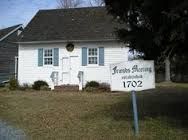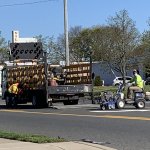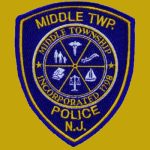SEAVILLE – Many travelers take Route 9 through Seaville without realizing they are driving past one of the most important structures in New Jersey: Seaville Quaker Meeting House. Even at Christmas, which historically Quakers did not celebrate, (the Meeting House was not decorated even with a few lights or a wreath), its importance goes beyond superficial adornment.
Seaville’s “Religious Society of Friends” worships in the oldest Quaker meeting house in New Jersey and is in fact the oldest house of worship continuously used in the state.
The “Quaker” name reflects adherents’ belief that they “tremble in the way of the Lord.” Historians believe the structure itself probably was built in 1702 and there are Minutes of Meeting dating from that time.
Cape May County’s Quaker colony was founded even earlier, in 1693, by settlers migrating from Nantucket and other Massachusetts towns. Some were following the whaling industry farther south but many were escaping terrible persecution and even torture in the New England colonies, the same type of harsh mistreatment that had brought them to the New World from England.
“Our meeting is comprised of about 38 adults,” explains Recording Clerk Barbara Jean (B.J.) Chadwick, “and we are committed to the social testimonies of tolerance, peace, non-violence, and equality that are the religious principles defining Quakerism.” Chadwick’s role of Recording Clerk is a significant one in that she serves as a sort of first among equals qua leaders of the Seaville Meeting and dedicates much of her time to supporting various community actions to help those in need, such as eight different “food cupboards.”
The Seaville “Monthly” Meeting belongs to the Salem “Quarterly” which then forms part of the Philadelphia “Yearly” Meeting, one of the three largest in the world. The other two are London and surprisingly Kenya which “is not so surprising,” explains Craig Gras, “since its country’s form of governance at the village level is similar to Quakerism’s decision-making among equals.”
Another committed Seaville Friend, Gras highlighted Quakerism’s focus on consensus which might make decision-making more protracted but that serves to reflect the unanimous voice of the Meeting. “One of the decisions that took quite a bit of time to reach was the process to approve the marriage of a same-sex couple quite some time ago,” explained Gras. “One of our Meeting’s more conservative members was not in favor of this marriage taking place here but over time he eventually agreed.”
The early 1700s saw Cape May County’s Quaker population grow to about 4.7 percent of the total. Contrast this figure with 50.8 percent in Burlington County and 43.3 percent in Gloucester County both forming part of what was termed at the time “West New Jersey.” By 1745 South Jersey’s Quaker communities, including the one in Seaville, began to dwindle as Methodist missionaries began making proselytizing in-roads to convert them.
Those earliest Quaker populations had been attracted to America by William Penn’s promises of religious tolerance as he created his new “City of Brotherly Love,” Philadelphia. Penn, a true visionary, had acquired in 1681 an enormous tract of land in the New World because of a very large debt Charles II owed his father.
Friends were attracted by Penn’s assurances that they could safely practice their faith. It is believed even George Fox, founder of Quakerism, visited Philadelphia and also travelled to Cape May County in 1688 to observe first-hand this religious utopia.
Quakers were religious dissenters of the Church of England. As a result they were targets of severe persecution much like the Puritans experienced. Quakers were devout pacifists and would not fight in any of England’s wars, nor pay any tax that they thought might be used for military purposes. Since they also believed in total equality of all, they would not bow to the king or even tip their hats to him nor swear any oath of allegiance including to him.
These same characteristics of their faith also engendered the wrath and hatred of the leading figures governing where they landed in the New World. John Townsend, one of the eventual pillars of Cape May County development in the 18th century, left Rhode Island in fear of his life as he witnessed his fellow Quakers executed all around him. Arriving in South Jersey, he was befriended by the Lenni Lenape who enjoyed a peaceful relationship with the Quakers for decades based on the Friends’ non-threatening and respectful demeanor towards them.
Ironically, Quaker traits of pacifism and non-discrimination made them leading voices of reform throughout America’s history as abolitionists and fierce supporters of women’s equality, child labor regulation, anti-gun legislation and gay rights.
Many of the earliest Quaker meeting houses may have looked like the Seaville meeting house and in fact for this area its similarity to a cedar-shingled beach cottage is not out of place. But it is unusual in a critical respect: it was built entirely of wood, locally-harvested cedar, while many of the first and later meeting houses in America were traditionally constructed out of area stone or brick.
Although official records are inconclusive, it is plausible that the Seaville Meeting House probably was first built in the Beesley’s Point area and there may even have been another meeting house in Somers Point. Friends could have come together for worship in alternating locations travelling by boat back and forth across the bay to worship together. The Beesley’s Point Meeting House could have been constructed by local ship builders, hence the unusual material, wood, that they used.
Quaker lore is that this Meeting House was taken apart and moved to its present location in Seaville on Route 9 around 1716 although “my personal opinion is that it probably was moved from a northwest quadrant of the county,” said Chadwick.
As a religious doctrine, the Quakers do not believe that meeting for worship should occur in any special place. Rather, they are guided by the Biblical verse that “where two or three meet together in My name, I am there among them” (Matt 18:20). In fact, Quakers use the word “church” to mean the body of people who make up the worshipping community, not the actual building where one prays.
The hallmark of a Quaker meeting house is its extreme simplicity and the absence of any liturgical symbols. Seaville’s Meeting House is one small room entirely made of wood with a few rows of basic hewn benches perpendicular to each other facing a small cast-iron stove.
Other larger meeting houses built in the same traditional style such as the Seaville Meeting House have two rooms: one for the main meeting for worship, and another where the “women’s business” meeting could be held although Quakers do not treat women differently than men nor were they separated for worship.
These slightly more elaborate meeting houses have a minister’s simple table at one end of the meeting room, many of whom were itinerant ministers travelling to different churches, with an elders’ bench immediately in front of this. Wooden benches facing the table occupy the rest of the room often with a gallery for extra seating.
Meeting houses usually have high, very small or no windows so that worshippers sitting in meeting cannot see outside and be distracted by the outside world. Thus, the meeting room itself is a place for Friends to withdraw from the world and enter into a silent time of prayer that enhances meditation and study to wait and listen for the divine presence. “We come to Meeting to have a quiet period of contemplation and find that inner voice that will speak to our condition,” says Gras, “and that is what I seek each time I am here.”
To contact Camille Sailer, email csailer@cmcherald.com.
Wildwood Crest – I have given all my money to Mr. Trump but it's not enough. So, I plan to sell my family at the big yardsale coming up in May. Please consider doing the same. He needs us. He is very weak…








